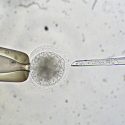From raw biomass, chemical process produces simple, fermentable sugars
A University of Wisconsin–Madison research team has developed a promising new chemical method to liberate the sugar molecules trapped inside inedible plant biomass, a key step in the creation of cellulosic biofuels.
The approach, which is described in the March 9 issue of the Proceedings of the National Academy of Sciences, can convert three-quarters of the sugars locked up in raw corn stover into simple, fermentable sugars, making it an attractive alternative to the enzyme-based approaches currently favored by biofuels researchers.
“Our chemical process is extremely efficient,” says Ron Raines, a UW–Madison professor of biochemistry and chemistry. “It also has marked advantages over the existing processes-both chemical or enzymatic-for producing sugars from biomass.”
Working under a strong federal mandate, scientists across the nation are developing next-generation biofuels from inedible plant materials such as corn stover, switchgrass and wood chips. Unlike most ethanol on the market today, these so-called cellulosic biofuels would not be derived from food sources, potentially reducing the stress on food systems. But the complex structure of plant material keeps cellulose’s energy-rich sugars locked up in tangled webs, making the process of converting it to fuel difficult. In recent years, scientists have been trying to find and engineer enzymes that can break down the sugars more efficiently, potentially opening the door to the commercial production of fuel from cellulose.
Raines’ chemical approach, which he developed with graduate student Joe Binder, a doctoral candidate in the chemistry department, on the other hand, relies on a mixture of an ionic liquid and dilute acid-both of which can slip past lignin-to dissolve the long chains of sugars in biomass and break them up into individual molecules of glucose and xylose.
Over the course of the reaction, they added water to the mixture to prevent unwanted byproducts from forming. After two rounds of such treatment, a sample of corn stover gave up about 70 percent of its glucose and 79 percent of its xylose, a 75 percent sugar yield overall. From there, the researchers used ion-exclusion chromatography to separate the sugars from the reaction mixture, as well as the ionic liquid, for reuse.
The sugar yields obtained using this method, says Raines, approach those achieved using enzymes to break down raw biomass. And chemicals, he notes, are more robust and less expensive than enzymes-and require no pretreatment of the biomass sample. “In the biofuels race,” says Raines, “I feel this sort of chemical approach has a good shot at winning.”
Raines and Binder subsequently used microbes to ferment the sugars they collected into ethanol. All told, says Raines, using this integrated process, they were able to convert half of the sugars available in plant biomass into liquid fuel.
To make it work at the industrial scale, however, a number of hurdles will need to be overcome, including the near-perfect recovery of the ionic liquid, which is expensive, in order to make the whole process economical. Nevertheless, says Raines, the technology is ready for the right entrepreneur.
“This work could have substantial short-term economic and political impacts,” he says.
Raines’ project was supported by the Great Lakes Bioenergy Research Center, a U.S. Department of Energy bioenergy research center located at UW–Madison, as well as a National Science Foundation Graduate Research Fellowship awarded to Binder.

